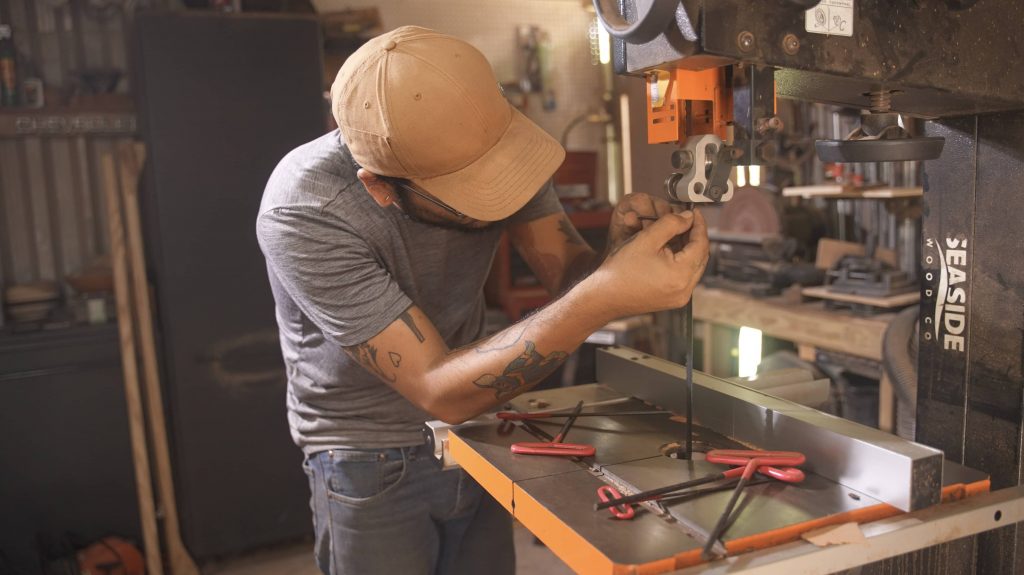A bandsaw machine is a power tool used for cutting various materials such as wood, metal, or plastic. It consists of a continuous band of toothed metal stretched between two or more wheels to create a rotating loop. It comes in different sizes and configurations, ranging from small benchtop models suitable for hobbyists and small workshops to large industrial-sized machines used in manufacturing facilities. They are versatile tools and are commonly used in woodworking, metalworking, and fabrication applications due to their ability to make intricate cuts and curves with ease.
Just like any other power tools, bandsaw machine consists of hundreds of different parts and it is the machine operator’s responsibility to know all of the band saw parts, and understand its usage.
Understanding the parts of the band saw machine is crucial for several reasons:
- Safety: Knowing the parts of a band saw machine helps users operate it safely. Understanding the location of switches, guards, and handles can prevent accidents and injuries.
- Efficiency: Familiarity with the parts allows users to operate it more efficiently. They can adjust settings, change accessories, and perform maintenance tasks more quickly and accurately.
- Maintenance: Understanding the components of a band saw machine helps users perform regular maintenance tasks such as cleaning, lubricating, and replacing worn-out parts. This can extend the lifespan of the tool and ensure optimal performance.
- Troubleshooting: When a band saw machine malfunctions, knowing its parts allows users to diagnose and troubleshoot problems more effectively. They can identify faulty components and take appropriate action to repair or replace them.
- Optimal Use: Different parts of the machine may have specific functions or features that can enhance its performance. Understanding these parts enables users to utilize the tool to its full potential and achieve better results in their work.
- Safety Compliance: In industrial settings, understanding the parts of a band saw machine is essential for complying with safety regulations and standards. Proper training on the tool’s components ensures that operators follow safety protocols and guidelines.
Overall, understanding the important parts of a bandsaw machine is essential for safe, efficient, and effective operation, maintenance, and troubleshooting, ultimately contributing to productivity, quality, and cost-effectiveness in various woodworking and metalworking applications.

Here are some of the most common parts of a band saw machine and its contributions towards providing quality result.
- Frame: The frame provides support and stability for the entire bandsaw machine.
- Table: The table is a flat surface where the material being cut rests. It can typically be adjusted for angle and height to accommodate different cutting requirements.
- Blade: The blade is a continuous loop of toothed metal that rotates around wheels to perform cutting operations. Blades come in various widths, tooth pitches, and materials depending on the material being cut and the desired cut quality.
- Blade Guides: Blade guides are bearings or rollers that support and guide the blade during operation, ensuring accurate cuts and prolonging blade life. Upgrade your bandsaw with our guide kits, specifically designed to outperform standard blade guides. Our superior bearings or rollers intensify the precision of your bandsaw, offering improved cutting experience and enhanced blade durability.
- Blade Tensioning Mechanism: This mechanism adjusts the tension of the blade, ensuring it is properly stretched and aligned for optimal cutting performance.
- Wheels: Bandsaw machines typically have two wheels, one above and one below the table, around which the blade rotates. These wheels are usually made of metal or rubber and provide the driving force for the blade.
- Motor: The motor powers the bandsaw machine, providing the necessary energy to rotate the wheels and drive the cutting blade.
- Dust Collection System: Some bandsaw machines come equipped with a dust collection system to remove sawdust and debris generated during cutting, improving visibility and reducing the need for cleanup.
Over time, components of a band saw can wear out or become damaged, leading to decreased performance. Replacing worn or damaged parts ensures that the band saw operates at its optimal level, producing accurate cuts with minimal effort.
| Bandsaw Part Name | Function |
|---|---|
| Frame | Provides support and stability for the entire machine. |
| Table | A flat surface where material is placed for cutting; adjustable for angle and height. |
| Blade | A continuous loop of toothed metal that performs the cutting operations. |
| Blade Guides | Bearings or rollers that support and guide the blade, ensuring accurate cuts and prolonging blade life. Upgradeable with kits for improved performance. |
| Blade Tensioning Mechanism | Adjusts blade tension for proper alignment and optimal cutting performance. |
| Wheels | Two wheels, one above and one below the table, which the blade rotates around. |
| Motor | Powers the machine, driving the wheels and the cutting blade. |
| Dust Collection System | Removes sawdust and debris during cutting to improve visibility and cleanliness. |





